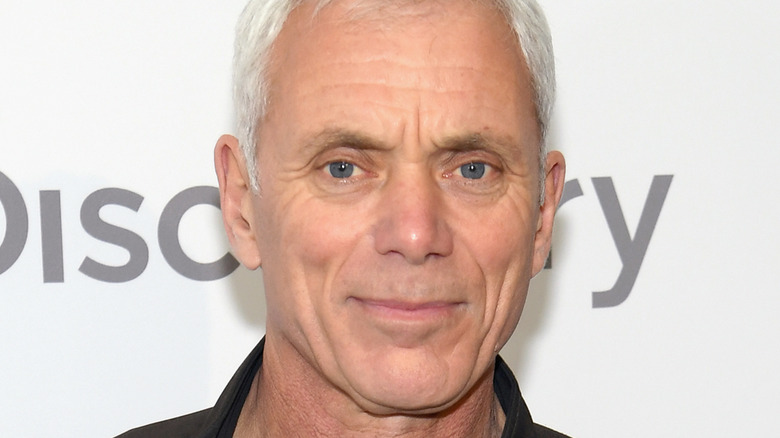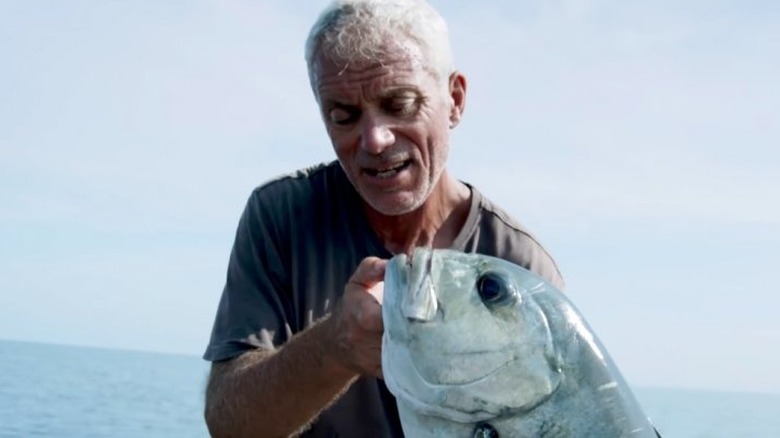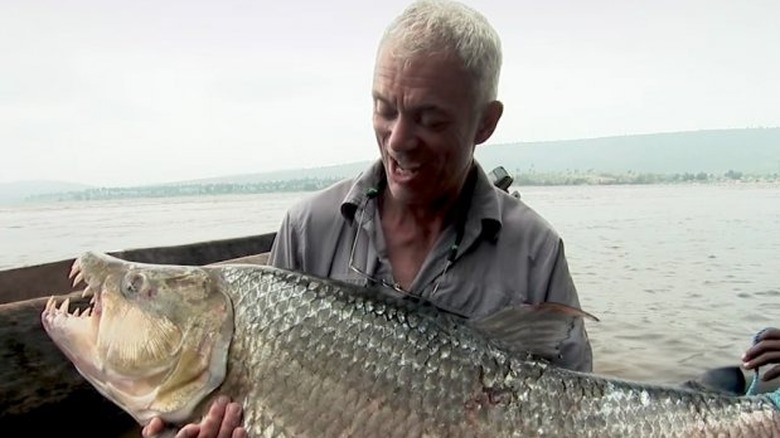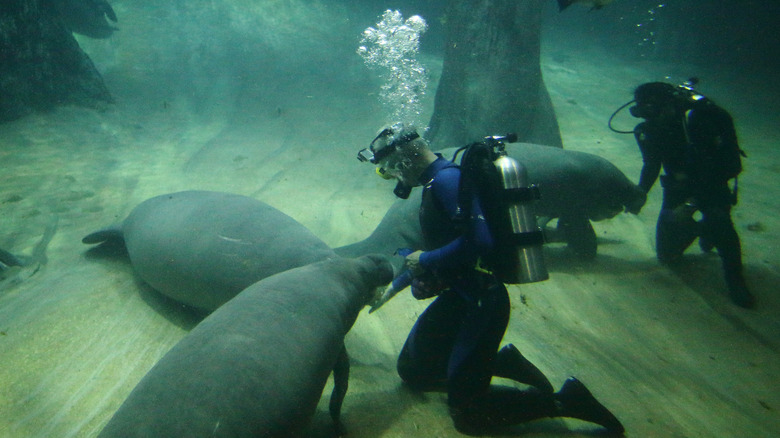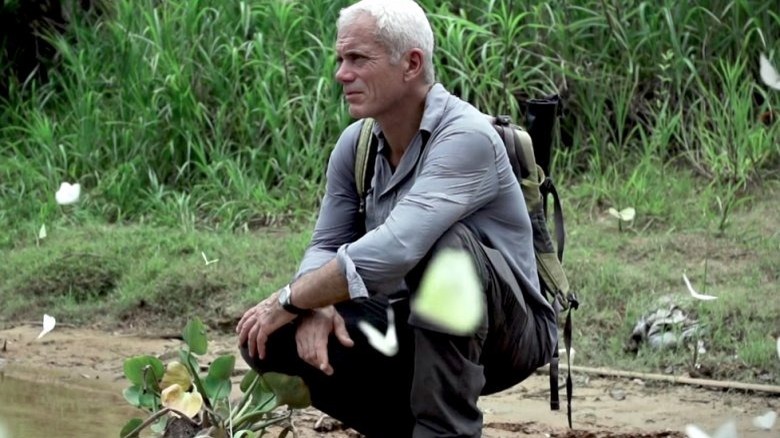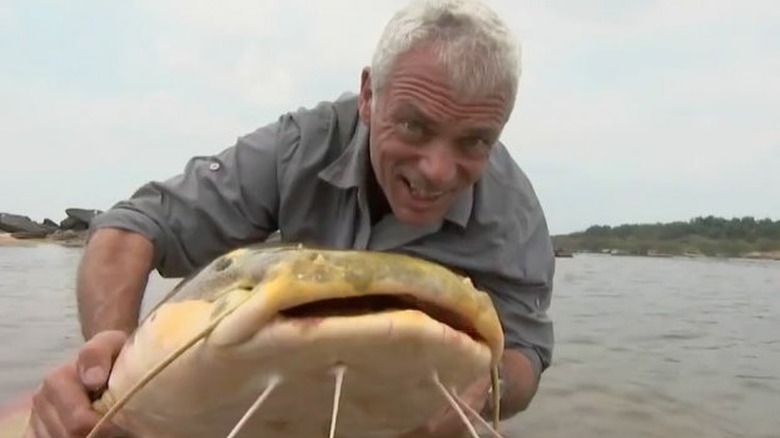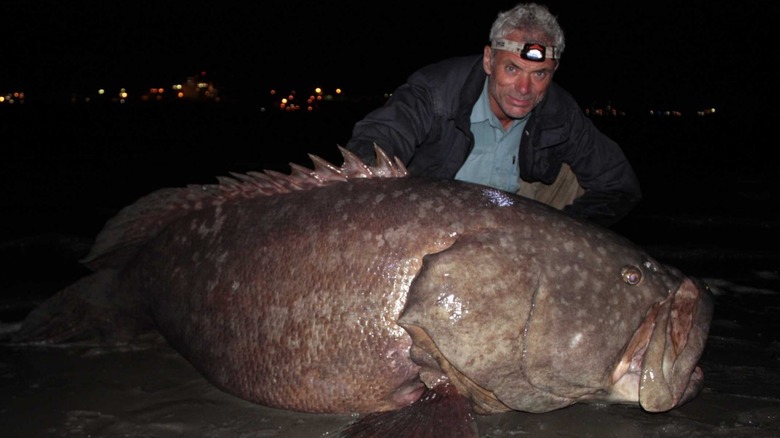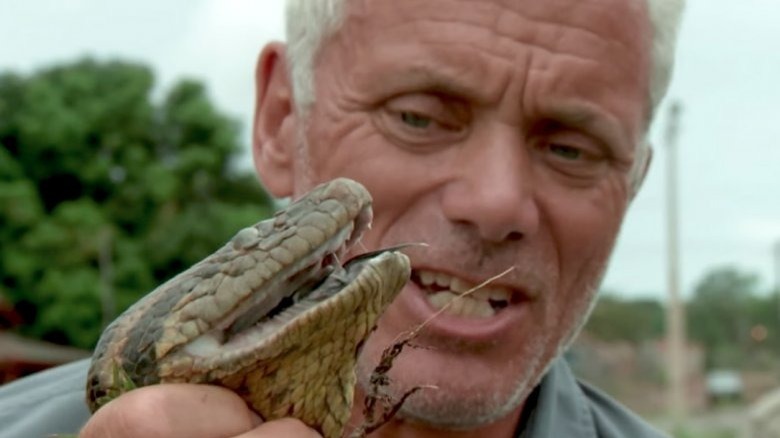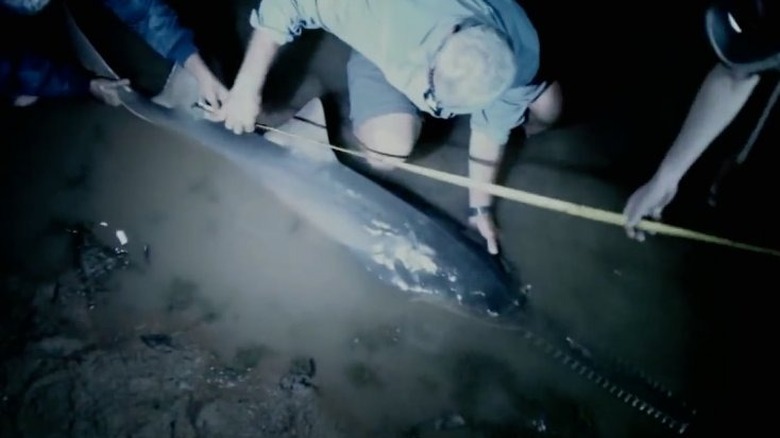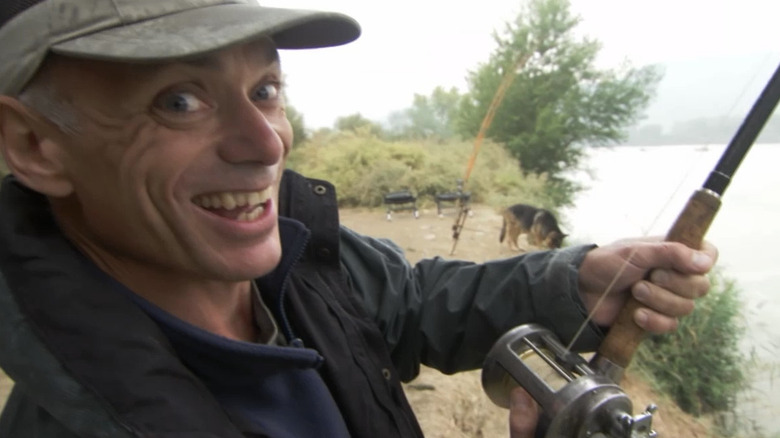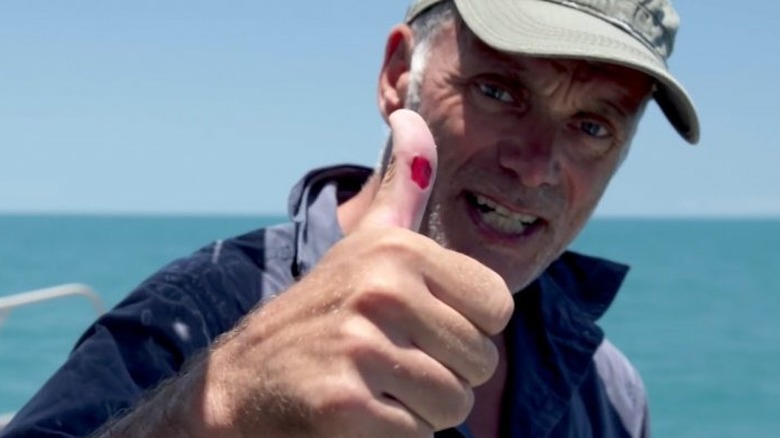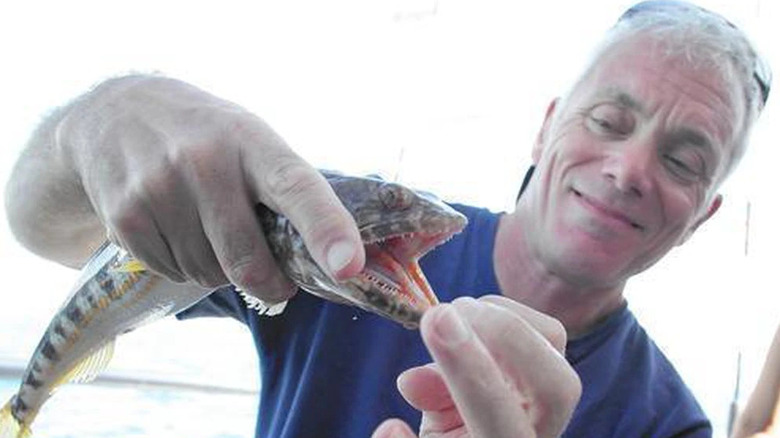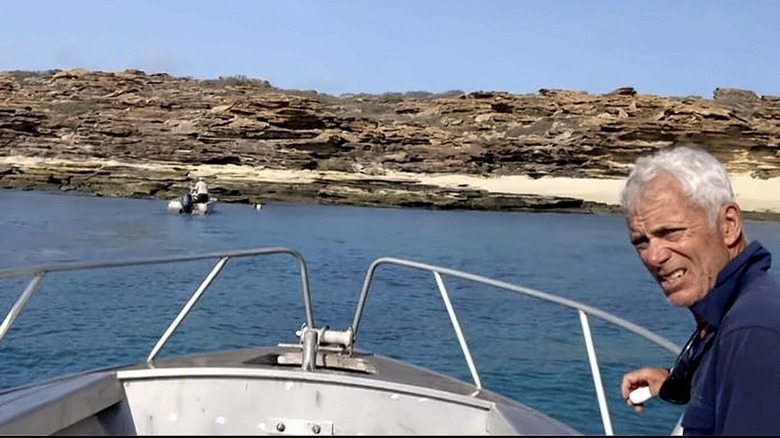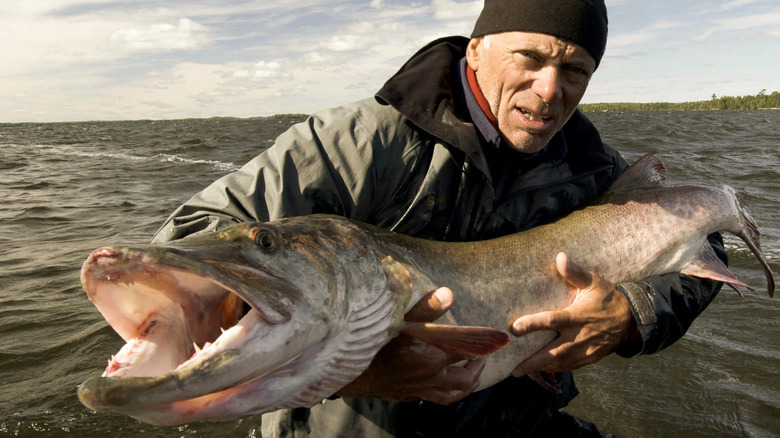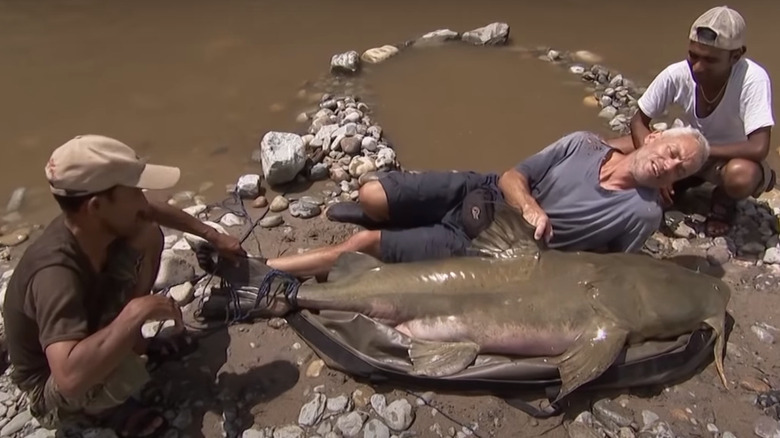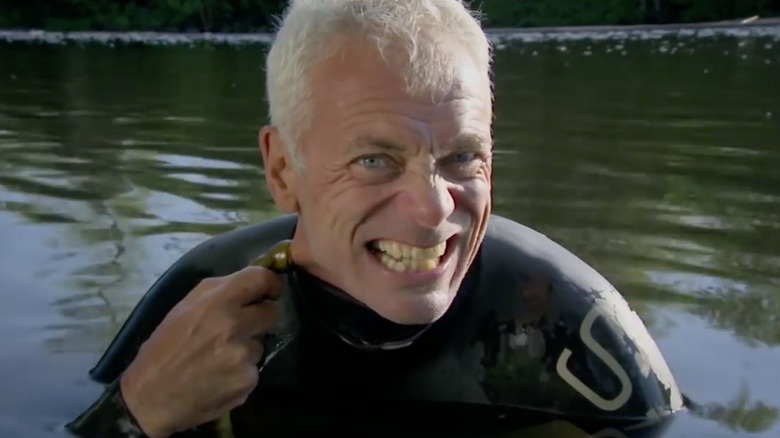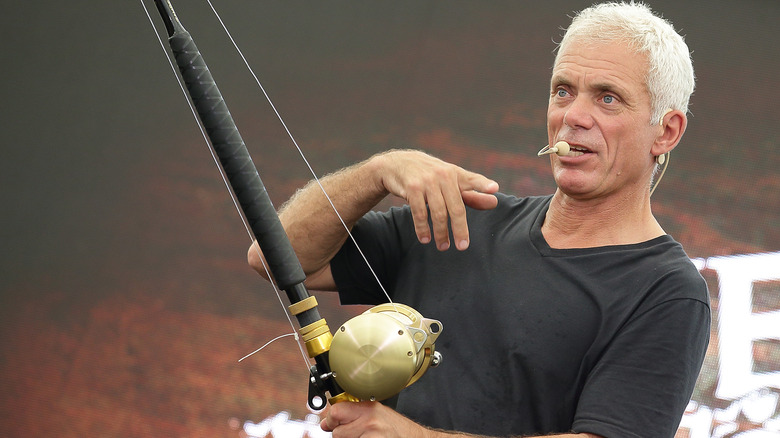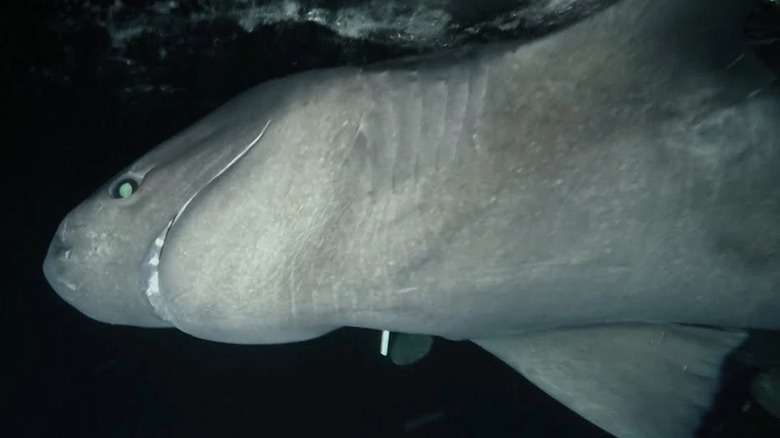The Untold Truth Of River Monsters
"River Monsters" is the hit Animal Planet show that followed adventurer and extreme angler Jeremy Wade all over the globe in his search for the rarest and most terrifying freshwater fish in existence — not the oozy CG creatures from the movies, but the real-life species that spawned the legends. While many other nature-based reality shows are clearly staged, "River Monsters" was regarded as one of the most authentic, mainly thanks to Wade's obvious passion and thorough knowledge of the titular beasts that lurked in the murky rivers, lakes, and ponds he visited.
But for a show ostensibly about one man going fishing, "River Monsters" had a surprisingly storied and eventful history over its nine seasons. Here's a look at how the show came to be, how the cast and crew managed to keep it going in the face of nature's wrath, and some interesting lesser-known facts about the fishing show. This is the untold truth of "River Monsters."
Jeremy Wade used to just do this for fun
What started out as a childhood hobby turned into a lifelong passion for Jeremy Wade. Speaking with Wanderlust, he revealed that he learned how to fish from a friend and subsequently started angling in the local waterways of his rural English hometown. When the hobby became too popular locally, Wade took a three-month trip to India — the first of his many international fishing excursions.
After the trip, Wade longed to explore other remote areas for fish, which led to a period of simple living and working odd jobs until he'd saved just enough for his next journey. Wade even nearly died from malaria during one trip on the Congo River, yet he returned to the same area multiple times. Eventually, he started making a little money writing for fishing magazines, but his main purpose in life seemed to be simply to travel, discover, and fish.
One fish took Jeremy Wade 25 years to catch
Jeremy Wade often talks about one of his favorite catches being the Goliath tigerfish, which is a kind of giant piranha only found in the Congo River that can weigh over 100 pounds. In an interview with The Telegraph, he revealed that he traveled to the region three times over a six-year period -– before "River Monsters" –- until he caught "a medium-size one." But of course, that wasn't enough for the guy who'd eventually build his career on hooking the biggest, rarest fish in the world.
The show returned to the Congo River in its second season despite Wade's admission that "traveling there is very tiring and potentially dangerous." Nonetheless, he ended up hooking a 78-pounder, which Wade described as "the big one I had been after for almost 25 years." The images of Wade holding the Tigerfish are oddly poetic, featuring his bright, beaming smile alongside the fish's own set of razor-sharp teeth.
Climate change affected the show
Water levels greatly affected Jeremy Wade's ability to find and catch monsters of the deep –- in fact, there are certain times of the year when fish are so spread out due to high floodwaters that, as Wade told The Big Lead, "They can be impossible to find." Some of that predictably has to do with climate change, which Wade once said made the annual river cycle "unpredictable" in more recent times (per Metro). Of course, rising global temperatures have other detrimental effects on aquatic wildlife as well.
Speaking with The Guardian, Wade said, "There has been a marked decline in fish sizes over the last few years. I've witnessed that myself and [by] talking to people." He said that his preferred catch-and-release approach is "the only way that freshwater fish stand a chance, worldwide." Given that Wade is such a dedicated biologist, it makes sense that he cares so deeply about all other elements of the planet's health as well.
The show helped scientific research
A conservationist and environmentalist at his core, Wade once stated in a Reddit AMA that part of his mission with "River Monsters" was science education. "And what is great now is having the platform to inform people about what lives in our lakes and rivers, which ... was not on people's radar at all," Wade said. "And looking after our rivers is quite an urgent concern. But people need to know of the existence of these creatures before they can start caring about them."
To that end, Wade also told Metro that he's "worked with scientists to catch bull sharks in South Africa and tiger sharks in the Bahamas" so they can be tagged and studied. He also said he's been able to help scientists get close to fish that are "under a particular threat" so they can retrieve specimens and collect DNA samples. Turns out, "River Monsters" isn't just about Wade getting trophy pics next to fiercely fanged fish.
Wade found all of his monsters
When "River Monsters" started, it would have been hard to imagine the phenomenon it quickly became. Jeremy Wade surely had a good number of ideas for episodes based on his own research and study, but with the series eventually going nine seasons, a lot more creatures got added to the list. Later on, the show even dipped into more sensational waters with its Chernobyl and Loch Ness Monster episodes.
Instead of riding things out until low ratings or a lack of ideas forced the show off the air, Wade and his team decided to hang it up once they felt they'd wrangled every river monster out there. "Some shows can run forever, but our subject matter is finite," he wrote in a press release announcing the end of the series (via Mic). "Ten years ago, I had a list in my head, which seemed impossibly ambitious at the time, but everything has now been ticked off -– and then some."
The show was criticized for demonizing the creatures
In 2013, YouTuber and science writer Kyle Hill penned an open letter to the creators of "River Monsters" in Scientific American, voicing his concern over what he viewed as the show "taking up the torch and pitchfork as if these amazing animals truly were abominations." Hill's argument is that the colorful terminology used to describe the animals, like "killer, man-eater, assassins, and flesh-eaters," combined with the show's graphic reenactments of the stories of monster attacks, contributed to a wrongful perception that could lead to the "mostly harmless" animals being "feared or killed."
"If you reach into the mists of pseudoscience just to pull out some good ratings, while at the same time demonizing some of the most astounding subjects of biology I have ever seen on the end of a fishing line," Hill said, "it won't be long until the only monsters out there will be us." That's pretty dramatic, but in fairness to Hill, he did give Wade his dues as being "incredibly concerned for the well-being of these fish."
Wade responded to Hill in Discover Magazine, admitting to the sensationalism, but saying it was to help the show reach a "wide and diverse audience." Specifically addressing Hill's claims of fear-mongering, Wade wrote, "So while the programs do have a theme of fear, it's a positive message: instead of hiding from the thing you fear or trying to destroy it, you work to understand it and through understanding find that you can live with it."
Wade's one true fear is on land
Over the course of his adventurous life, Jeremy Wade has contracted malaria, had a gun pulled on him, and been interrogated by authorities on suspicion of spying –- and that's all before "River Monsters" even began. Since then, he's been bitten, jabbed, and rammed in the chest by an 80-pound arapaima in the Amazon so hard that his heart was bruised. Crew members on the show were even struck by lightning in one episode — an event that was captured on film.
But when asked by Wanderlust what the biggest danger in "going after these big fish" was, Wade had a surprising answer. "The thing that I worry most about is road traffic," he said. "Indian mountain roads, for instance. No tread on the tyre [sic], a driver whose belief is that it is karma that will decide his fate, not the state of his vehicle." From the man who voluntarily attached a bloodsucking lamprey to his own neck, it makes sense that Wade's personal bogeymen aren't aquatic. Still, given all the dangerous things he's done professionally, perhaps he should have a little more faith in the people behind the wheel.
The one fish that totally grossed Jeremy Wade out
During his Reddit AMA, Jeremy Wade revealed (somewhat unbelievably) that he's most creeped out by the Candiru Asu — and not the one that's been known to "penetrate the urethra of a human being" and can only be removed by surgery. It's in the same family, but a little larger –- Wade estimates "about the size of a finger."
Describing it as a "scavenging catfish in the Amazon" that "takes circular bites out of flesh," Wade wrote, "It just feels very disgusting to handle. It's very slimy and wriggly and just looks creepy. They have tiny luminous eyes." He doesn't mind grabbing flesh-eating piranhas or the freshwater sawfish whose mouth literally looks like a hedge-trimmer, but he's thoroughly creeped out by a tiny thing with beady eyes. Having seen and touched so many different creatures, it's difficult to predict exactly what actually scares Wade.
River Monsters started with a documentary
As previously mentioned, Jeremy Wade wasn't specifically (ahem) angling for a TV show when he started documenting his worldwide fishing expeditions; he was simply a biologist with a passion for conservation and education. It was only after a producer saw a newspaper photo of Wade holding a huge fish from the Amazon that he got his first shot — a 2002 documentary called "Jungle Hooks," which saw him return to the Amazon and capture a 200-pound arapaima.
"Jungle Hooks" also captured the harrowing plane crash that Wade and his crew survived after their single-engine aircraft went down in the trees of the rainforest. A few years later, Wade got the green light for a limited series based on Jungle Hooks," which resulted in a trip to India and the capture of a 60-pound goonch that eventually caught the eye of Animal Planet. The rest is history.
A cameraman refused to film one of Wade's injuries
"River Monsters" is known for its dramatic reenactments of supposedly terrifying and sometimes deadly encounters that people have had with monstrous freshwater giants. Part of the drama of the show is the knowledge that Jeremy Wade and his crew could be seriously injured or even killed in pursuit of their prey, which is why Wade was so surprised during the first season when a cameraman refused to shoot an injury he sustained during production.
In an interview with TV and City, Wade said one of his "most dramatic injuries" was never recorded because the cameraman took it so seriously. "We've got real blood, we're making a program about bull sharks," he recalled, "and he was just saying 'no you're hysterical, we've got to get you to a hospital.'" In fairness to the cameraman, Wade's injury was the result of getting his hand "shut in the door of a vehicle," so it doesn't exactly sound fishing-related. Nevertheless, the show later utilized a five-to-seven second "preroll" function on the cameras, which gave them the ability to recapture those moments before the record button was even pressed. Wade may be an expert fisherman, but he also learned a thing or two about making compelling TV along the way.
A lot of the show's viewers were female
It's easy to assume that the demographic watching fishing shows like "River Monsters" would be primarily male. However, that's not as accurate as you might think when it comes to the Animal Planet show. According to a Chicago Sun-Times report from 2012, the series' audience was 40 percent female.
Though that number might sound surprising at first, it shouldn't necessarily be a shock. More modern data shows that close to 40 percent of fishing participants in the U.S. are women (per Statista). Wade also did a fabulous job as the host of "River Monsters," creating a tone that was widely accessible to anyone interested in freshwater biomes. Wade himself has expressed a humble perspective on the show's broad appeal, telling Real Screen, "We decided early on to go at this as a bit of a detective story. We're also showcasing different areas of the world and different people, which audiences are interested in."
Wade and the crew were trained to deal with medical emergencies
Given that many "River Monsters" locations are remote jungle regions, the danger posed by injuries is heightened beyond your average reality show. In a Reddit AMA, Jeremy Wade explained that because episodes were often filmed in places with "no emergency services," both he and the crew were trained for hazardous situations. "We have very small trauma packs which will include dressings, nasopharyngeal tubes for airways, EpiPens, those kind of things, just basic simple stuff," he wrote. "We also have a satellite phone so we can get advice and inform our production company if anything happens, if we have reception."
That all makes sense, given the circumstances, and the training has certainly come in handy time and again. But in the same post, Wade then tacked on this little tidbit of info: "And the production company always asks two questions on the rare occasions we call them if there is an emergency. Question one: is everybody okay? Question two, immediately afterwards: did you film it?"
The show rescued a castaway
Over its eight-year run, "River Monsters" sought out scores of creatures -– fish, crocodiles, giant salamanders, turtles, dolphins, octopi, squid, snakes, and more. One of the show's unerring constants was the fact that Wade inevitably caught what he was after, or at least a comparably bizarre fluvial beast. But of all Wade's finds, intentional or not, the single most surprising –- undoubtedly to cast, crew, and viewers alike -– was a marooned sailor on an unpopulated island.
While filming the Season 8 episode "Death Down Under" in Northern Territory, Australia, Wade and crew spotted something unusual, even for them: A typical, blue and white cooler sitting on an otherwise uninhabited island. The team spotted the colorful cooler and it led them to spot its owner — a sunburned, dehydrated fisherman who, upon spotting the team, yelled out "water" again and again (per ABC News).
The man, later identified as local fisherman Termini, told the crew that he had lost track of his boat while hunting for oysters on the small island, known as Barranyi North Island. As Wade notes in the episode, the area's average daily temperature hovers around 100 degrees Fahrenheit, and the extreme heat had taken a toll on Termini. Though he had already "said his last prayer," the "River Monsters" crew were able to rehydrate him, rescue him, and bring him back to civilization for medical treatment (via HuffPost).
One fish made Wade lose it
Despite the multitude of impressive catches that Jeremy Wade has made over his decades-long career as a biologist and researcher, some tricky critters continued to vex him. The Season 7 episode "Canadian Horror" follows Wade as he meets (or more accurately, repeatedly fails to meet) one of the most elusive critters of them all: The muskellunge.
The episode, like many before it, begins with Wade and company investigating a local legend, this time in Ontario, Canada. The story tells of a giant monster menacing a series of freshwater bodies. Searching for a real-world explanation for the alleged monster sightings, Wade begins ruling out suspects, such as sturgeons, sharks, and snakes. Finally, he lands on the most likely culprit — the large, predatory pike known as the muskellunge.
It's also known as "the fish of 10,000 casts" –- referencing how many attempts it takes to haul in the elusive animal –- and unfortunately for Wade, the muskellunge proved that moniker insufficient. Wade made the requisite 10,000 casts using a range of lures, and still he had no muskie. Nearing 13,000 casts, Wade began to lose it, reaching "a level of frustration ... almost unlike anything I've experienced before." He began casting in search of any fish that would bite, hoping to "feel anything at all," on the end of his line, and as he passed 13,000 casts, he finally hooked one miraculous muskie.
River Monsters was often challenging to make
You'd be forgiven for assuming that the "River Monsters" production team had it easy. An average episode consists almost entirely of Wade spending countless hours angling and baiting, so it would be fair to think that the crew would mainly be in charge of travel, food, shelter, and occasional filming. But many episodes of "Rivers Monsters" took a heavy toll on the crew's time, money, sanity, and even safety.
As Wade has discussed before, each episode of the show took around three weeks to shoot. That length may already surprise, but what's perhaps more surprising is that, as Wade has said, "Only about three or four days, normally, are spent fishing." That leaves around 18 days during which the crew would focus on non-fishing hurdles, and there were hurdles aplenty. For example, director Kelly Neaves has detailed a few such issues that the crew faced while searching for Humboldt squid in Peru (via Discovery UK). The challenges, some of which were typical for "River Monsters" shoots, included a boat too small for the crew, a language barrier between crew and guides, ocean sickness, lack of safety precautions, and even the threat of pirates -– for which the team swung a naval escort.
Production did some damage
As you might expect from a show with so many obstacles to tackle in its production, the cast and crew of "River Monsters" didn't walk away unscathed. The number of injuries, illnesses, and general damages inflicted upon the "River Monsters" team are as numerous as they are cringe-inducing.
In an interview with Entertainment Weekly, Jeremy Wade listed a few of his closest brushes with death during the making of "River Monsters" -– only some of which actually came from monsters. Though he avoided almost certain death while handling an electric eel, even going so far as to bring an emergency defibrillator if his heart should stop, Wade was not so lucky with either the arapaima or catfish. The latter stabbed him in the hand and injected him with its "toxic slime" and the former smacked him in the chest so hard that Wade feared he had serious cardiac damage. Wade and company's injuries were so numerous that Animal Planet began cataloging the more notable examples in a multi-part series on YouTube, with one in particular –- a torn tendon resulting from a battle with a stingray –- receiving its own installment.
Jeremy Wade is trophy-less
Despite the numerous monsters that have taken a bite out of Jeremy Wade –- not to mention tail-whipping, head-butting, body-slamming, stabbing, and shocking him -– he's not a vengeful man. Wade has always conducted himself as a biologist and researcher first, and an angler only as a secondary necessity. To that end, Wade doesn't keep trophies from his catches, even the incredible ones, and he avoids eating fish for the most part.
During an AMA on Reddit, Wade revealed his sustainability-based policy when it comes to piscivory, saying that the only fish he eats are "small fish that I catch if there's plenty of them in the river." He explained the choice further to Page Six, saying, "It's sort of out of conscience ... I like to eat sustainably produced fish where possible." For the same reason, Wade isn't interested in keeping fish as trophies. His angling expeditions are meant to educate and assess local ecosystems, which is why almost every "River Monsters" catch can be seen on camera swimming away after its brief run-in with Wade. To supplement his on-site adventures with at-home education, Wade also frequently lectures about conservation at universities and scientific conferences, as well as contributing to various ecology journals and newsletters.
One river monster beats them all
When it comes to animals, the term "biggest" is practically useless. Depending on how an animal is positioned and its rotation, it could be the tallest among a group or the shortest. For that matter, how do you define the difference between tallest and longest? Some biologists are more interested in mass, making "heaviest" one of the best objective metrics for judging an animal's size. But no matter which definition you use, and despite the hundreds of mammoth catches in Jeremy Wade's long career, one creature beats them all in nearly every statistic.
In the "River Monsters" Season 9 episode "Killers From The Abyss," Wade hooked an extremely rare bluntnose sixgill shark –- one of the largest shark species in the world. The specimen Wade landed was estimated to be around 13 feet long and 1,100 pounds. The shark was one in a series of large catches during the episode but dwarfed all the others. It required specialized, strengthened gear to bring in, and even then it was a tremendous struggle. The sixgill was so long and so massive that it even beat Wade's previous biggest haul, which he described as "one of the largest bull sharks ever caught."
